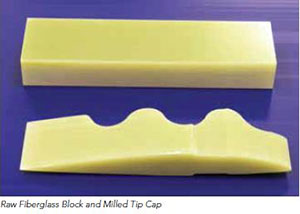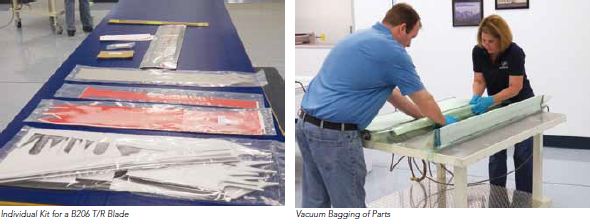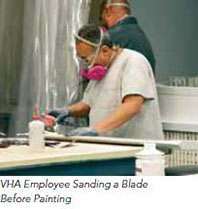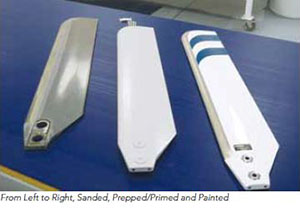
Carbon Fiber – A New Spin for Main and Tail Rotor Blades


In the early days of aviation, airplane wings were constructed of wood and fabric because this was the technology of the time. These materials served the industry well enough for many years. When it was time to build rotor blades for the first helicopters, the designers didn’t know how to construct them, so it’s not surprising that rotor blades were constructed similar to the wings on airplanes.
Like airplane wings, early rotor blades had a main spar, ribs and a fabric covering. The blades were symmetrical because this shape offered a good lift-to-drag ratio, a stable center of pressure, and they were easy to build. This was to be the design and shape of rotor blades for many years. The early blades were a blend of several types of wood, each adding properties the other materials lacked.
Early on, there were some problems with the wooden blades. Even though they were called “infinite life” or “on condition” blades, they could be damaged beyond repair. They always flew as sets that were matched to each other during the manufacturing process. If you scrapped one, you scrapped them both. They also absorbed water, and if one blade absorbed more than the other while the helicopter was parked outside, the resulting lateral vibration made things interesting at startup.
Metal Blades
Because of these problems, metal blades began to appear and allowed a user to replace individual blades instead of the whole set. This made life easier for the operator if a blade were damaged. Also, these metal blades came with a design life that made replacement mandatory after a certain number of flight hours. A big disadvantage was that when a metal blade was damaged or cracked in a critical area; it could experience a catastrophic failure with little warning. The introduction of honeycomb in blade construction allowed designers to incorporate more desirable shapes into rotor blades that increased performance. The combination of metal skins bonded to honeycomb provided great beam strength. The metal blades were a forward advancement, but construction methods available at the time limited the design progress considerably.
Along Came Composites
When the first non-metallic blades appeared with fiberglass skins and foam or Nomex honeycomb core, they offered something that had not been available before: a non-catastrophic failure mode. This is desirable in a single-load path structure. Whereas the older metallic blades would crack around a nick or damage, sometimes failing suddenly, these newer blades would give plenty of warning if they developed problems. Metal skins act somewhat like aluminum foil and tear easily. With a crack having no reason to stop, it could grow very quickly and sometimes fail the blade.
With fiberglass skins, each cross fabric resists crack growth like trying to rip the fabric of a shirt. What results is a non-catastrophic failure mode that gives visible indications of the damage or warns the pilot with a gradual increasing vertical vibration.
The following interview is with James Van Horn of Van Horn Aviation (VHA) in Tempe, Ariz. VHA specializes in the design, certification and manufacturing of aftermarket dynamic components for various rotorcrafts.
Van Horn, a mechanical engineer and former U.S. Army helicopter pilot, founded VHA in 2001. Formerly the chief engineer for McDonnell Douglas on its MD500 line and the revolutionary NOTAR system, and a founding partner in MD blade supplier Helicopter Technology Company (HTC), Van Horn founded VHA to improve the performance of various helicopter rotor blade systems through design, engineering and manufacturing processes.
Today VHA manufactures composite tail rotor blades for the 206/OH-58 and UH-1 Huey series of aircraft. VHA holds FAA, EASA and Transport Canada STCs for the 206/OH-58 blades, and FAA STC SR02051LA for the UH-1 blades. VHA is also currently developing new composite tail and main rotor blade designs for various helicopters.
HeliMx – By definition, what is/are composite material(s) for aviation use?
VanHorn – Traditional composite materials used in aviation contain fiber embedded in some sort of matrix material, with epoxy being the traditional matrix for composites. Examples of fiber materials include fiberglass, carbon fiber and Kevlar. There are also different resin systems including epoxies and polyester. At VHA, we’re using carbon fiber prepreg (carbon fiber sheets pre-impregnated with epoxy) for skins and spars. All structural components of our rotor blades are carbon fiber. The filler blocks, loads attach points and spacers are pre-cured fiberglass. The fiberglass arrives as blocks that are rough cut on the waterjet and then machined to the final tolerances with the CNC) mill.

Layup direction of the carbon fiber sheets is important in creating the strength and stiffness that you’re looking for in the structure. The fiber direction determines the structural characteristics that you want to create.
HeliMx – What is composite’s advantage over metal and rivets?
VanHorn – Composite parts are free of corrosion, exhibit better strength-to-weight ratio, contain fewer joints, and require a smaller part count. Also, composites allow more freedom of design with regard to placing the number and direction of plies where needed to obtain certain characteristics.
You can achieve an aerodynamically superior part when your component is designed and manufactured with composites since a composite part will hold a tighter outer surface tolerance than aluminum. A composite component should be truer to the design than metal. Rotor blades, wings, fuselages and fairings can all be manufactured truer to their design. Also, composite parts are more fatigue tolerant than metal.
HeliMx – Are there disadvantages?
VanHorn – Initial cost might be a disadvantage, depending on the factors you take into account. Ignoring cost, all the disadvantages could be placed in the manufacturing side. Composites are more labor intensive to fabricate. The handling and manufacturing involves more up-front labor, not only on fabrication of the component, but also the finishing.
HeliMx – How do you decide to repair or replace a blade?
VanHorn – We don’t repair blades at this time since we don’t currently have a repair station license. At some point in the future, we will apply to become a repair station and then we can control the repair process to our requirements. Without the need to go outside the company, we can ensure that the goals of our company from manufacturing through repair and inspection are all aligned.
We will probably have one or two dedicated repair experts who will dissect the blade to determine the problem and then issue a work order to VHA to perform the repair. From the business end of things, “VHA the repair station” will be a separate entity of “VHA, the company as a whole.”


HeliMx – How do you view the reparability of composite blades versus metal blades?
VanHorn – If you compare our composite blades with the metal blades they are replacing, our composite blades are generally more robust. Composite blades have so much carbon fiber that they resist the amount of damage that would normally ding or dent a metal blade. The composite structure can take more damage without coming apart, and often damage that would scrap a metal blade is repairable on a composite blade.
 One reason our blades are more robust is that we sacrifice elegance of design in favor of robustness. The two are not always exclusive, but they tend to be. We take a metallic blade with a certain weight and if we went with an elegant design, we could reduce the weight. However, since we are producing aftermarket blades with the goal of being essentially “bolt-on” replacements, we can add carbon fiber to the design to keep it at the same weight as the metal blade. Twenty-five pounds is 25 pounds, whether it’s metal or composite; the hub sees no difference. In effect, we have taken a stronger material and put more of it into the blade without a weight penalty. The net result is a blade that can absorb more punishment without failing. It can get hit with a hammer or a bullet and is less likely to fail when compared to a metal blade.
One reason our blades are more robust is that we sacrifice elegance of design in favor of robustness. The two are not always exclusive, but they tend to be. We take a metallic blade with a certain weight and if we went with an elegant design, we could reduce the weight. However, since we are producing aftermarket blades with the goal of being essentially “bolt-on” replacements, we can add carbon fiber to the design to keep it at the same weight as the metal blade. Twenty-five pounds is 25 pounds, whether it’s metal or composite; the hub sees no difference. In effect, we have taken a stronger material and put more of it into the blade without a weight penalty. The net result is a blade that can absorb more punishment without failing. It can get hit with a hammer or a bullet and is less likely to fail when compared to a metal blade.
Metal blades also tend to be much more complex in design. They may have pockets, multiple spars, ribs and closeouts, which introduce more possible failure points. If you take into account the various motions and forces acting on a rotor blade in flight, what in essence you have is a constant fatigue test in progress. Composites, by nature and by design, are more fatigue resistant than metal, resulting in an increased life.
HeliMx – How do you view the market for composite components looking down the road?
VanHorn – It’s going to increase. The manufacturing techniques, material selection and adhesives are all improving. To the consumer, there are only benefits from composite structures. The only disadvantages are manufacturing problems and those are being solved on a daily basis.
 HeliMx – What special tools are required to maintain and work on composite rotor blades?
HeliMx – What special tools are required to maintain and work on composite rotor blades?
VanHorn – The short answer is none. All special tools are required in the manufacture and repair of the blades, but none in the normal and routine maintenance of them.
HeliMx – What are the steps in the manufacturing process?
VanHorn – Our rotor blades start by kitting the subcomponents that go into the rotor blades. The primary components are carbon fiber laminates. We create precut assemblies of the epoxy pre-preg carbon fiber, adhesive and surfacing film. We gather all of the supplies — film adhesives, lightning protection mesh, surfacing film, epoxy filler blocks, and abrasion strip — and put them into kits. We then assemble the rotor blade, vacuum bag the entire assembly, and prepare it for the oven or autoclave. After the blade is cured, it goes into blade finishing; unbag it, clean off flashing, perform any final machining, prepare for paint and then paint.
HeliMx – From the operator’s maintenance perspective, what are the dos and don’ts of maintaining composites?
VanHorn – We tell our customers that if there is any paint erosion, maintain the topcoat of paint so it will protect the composite fibers from ultraviolet (UV) radiation and other damage. In terms of cleaning, don’t use anything harsher than what you’d use to clean the aircraft.
HeliMx – What tips on the care and feeding of composites would you care to share with our readers?
VanHorn – Respect the components. Avoid impact damage, which may cause underlying damage to the fibers. If you see an area that has flaking paint or a divot in the surface, then you may have damage.
There you have it, from wood to metal to composite materials, helicopter rotor blades are getting lighter, stronger and better every day.
